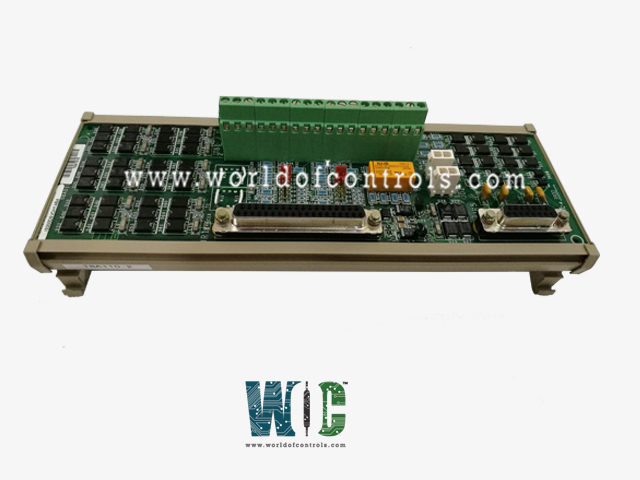SPECIFICATIONS
Part No.: IS200DSVOH1ABA
Manufacturer: General Electric
Country of Manufacture: United States of America (USA)
Size: 23.8 cm high x 8.6 cm wide
Temperature: -30 to +65 oC
Product Type: Servo Terminal Board
Availability: In Stock
Series: Mark VI
Functional Description
IS200DSVOH1ABA is a servo terminal board developed by GE. It is a part of Mark VI control system. The DSVO board serves as a pivotal component within industrial control systems, offering a compact and versatile solution for servo control applications. Designed specifically for DIN-rail mounting, this board integrates seamlessly into control cabinets, optimizing space utilization while delivering robust performance.
Features
- Servo Outputs: With two servo outputs, the board enables precise control over servo mechanisms, ensuring smooth and accurate operation in various industrial processes.
- LVDT Position Sensors: The board features inputs for six LVDT position sensors, providing comprehensive feedback on positional data to ensure precise control and monitoring.
- Pulse Rate Inputs: Additionally, the board includes two active pulse rate inputs tailored for flow measurement applications, enabling real-time monitoring of flow rates to enhance process control and efficiency.
- Flexible Servo Coil Current Selection: The board offers flexibility in servo coil current selection, allowing jumper selection of servo coil currents ranging from 10 to 120 mA. This feature enables users to tailor the output to match specific application requirements, ensuring optimal performance and efficiency.
- Connectivity: To facilitate seamless integration into the system architecture, the board connects to the VSVO processor board using a standardized 37-pin cable. This uniformity in connection simplifies installation and ensures compatibility with other system components. Moreover, the identical cables used on the larger TSVO board enhance versatility and ease of maintenance across different board configurations.
- Space Optimization: In scenarios where space conservation is paramount, the boards can be vertically stacked on the DIN-rail, optimizing cabinet space utilization without compromising functionality.
- Scalability: The system architecture allows for the connection of two boards to a single VSVO processor board, providing scalability and flexibility as per application requirements.
Fault Detection
- Servo Current Out of Limits or Non-Responsive: One critical fault detection mechanism involves monitoring the servo current to detect any deviations from predefined limits or non-responsiveness. If the servo current exceeds specified limits or fails to respond as expected, a fault is triggered, indicating potential issues with the servo system.
- LVDT Excitation Out of Range: Another crucial aspect of fault detection is monitoring the LVDT (Linear Variable Differential Transformer) excitation to ensure it remains within the designated range. If the excitation signal strays beyond acceptable limits, it signifies a fault condition, prompting further investigation and corrective action.
- LVDT Feedback Out of Limits: In addition to excitation monitoring, the DSVO board also monitors LVDT feedback signals to detect any anomalies or deviations from expected values. If the feedback signals fall outside predefined limits, indicating potential inaccuracies or malfunctions, a fault is detected and flagged for attention.
- Failed ID Chip: Furthermore, the board incorporates fault detection for ID chips associated with connectors. If an ID chip fails or malfunctions, it triggers a fault condition, signifying potential issues with hardware identification or configuration.
Number of Inputs
- LVDT Windings: With support for 6 LVDT windings, the board enables comprehensive monitoring of positional data from multiple sources. These LVDT inputs provide essential feedback for precise control over servo mechanisms and other dynamic processes.
- Pulse Rate Signals: The board accommodates 2 pulse rate signals, allowing real-time monitoring of flow rates or other pulse-related measurements. These inputs are crucial for applications where accurate flow measurement is essential for process control and optimization.
- External Trip Signal: Additionally, the board features an external trip signal input, enabling the integration of external triggering mechanisms or safety interlocks. This input can be utilized to trigger specific actions or shutdown procedures in response to predefined conditions or events.
Number of Outputs
- Servo Valves: Offers 2 servo valve outputs, allowing precise control over hydraulic or pneumatic actuators. These outputs enable dynamic adjustment of valve positions to maintain desired system parameters or respond to changing operating conditions.
- Excitation Sources for LVDTs: To ensure optimal performance of LVDT position sensors, the board features 2 excitation sources dedicated to LVDTs. These sources provide the necessary excitation signals to power the LVDT sensors, enabling accurate measurement of positional data.
- Excitation Sources for Pulse Rate Transducers: Similarly, the board includes 2 excitation sources specifically for pulse rate transducers. These sources provide the required excitation signals to power the pulse rate transducers, facilitating accurate measurement of flow rates or other pulse-related parameters.
The WOC team is always available to help you with your Mark VI requirements. For more information, please contact WOC.
Frequently Asked Questions
What is IS200DSVOH1ABA?
It is a servo terminal board developed by GE under the Mark VI series.
What triggers a fault regarding output servo current?
A fault is triggered if the output servo current is either out of predefined limits or non-responsive, indicating potential issues with the servo system.
How does the system handle faults related to LVDT feedback signals?
If the regulator feedback (LVDT) signal exceeds predefined limits, a fault is triggered. In cases where the associated regulator has two sensors, the faulty sensor is removed from the feedback calculation, and the system continues using the data from the functional sensor.
How does the system handle hardware compatibility issues with connector JR1?
Connector JR1 on the terminal board is equipped with its own ID device, containing vital information such as the terminal board serial number, board type, revision number, and connector location. If a mismatch is encountered when the chip is read by VSVO, a hardware incompatibility fault is created, indicating potential issues with hardware identification or configuration.
